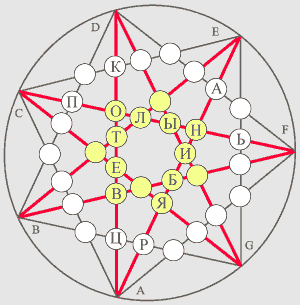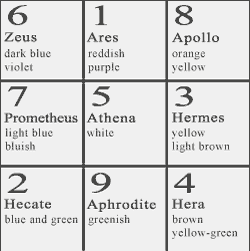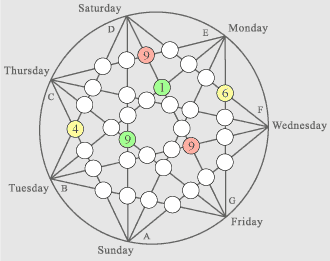Stones of a Japanese garden can be compared to letters of different alphabets, and including the modern Russian alphabet in which 33 letters are comparable to number of points (locuses) where lines of a heptagonal geometrical network are crossed, and where stones-symbols of letters can be located, that is shown on the chart:
 |
The heptagonal network of lines has 35 internal locuses
where it is possible to arrange 33 stones which are symbols of letters
in the Russian alphabet, and 2 locuses remain free, that allows to carry
out games and puzzles. In particular a puzzle can consist in moving stones by a heptagonal network in free locuses, and the task of a puzzle can consist in formations of words which should consist of six letters and should be located on seven lines shown by red color: AD, BE, CF, DG, EA, FB, GC. These lines form the heptagonal "Star of Magicians" and have 28 locuses where stones-symbols of letters should be located, and other letters can not be part of words, or words should be formed too on lines AC, BD, CE, DF, EG, FA as a result of a puzzle if such decision of a puzzle probably. For example, the chart shows the partial decision of a puzzle as a result of which words are formed: - the word - the word - the word |
More simple task of a puzzle can consist in formation of words which consist
of four letters and are located in locuses which on the chart are marked by
yellow color.
Such puzzle can be played by means of letters of the Latin alphabet, namely
stones of a Japanese garden can be symbols of Latin letters.
If ordinary word games and puzzles are not actual in a Japanese garden of stones
then it is possible to compare stones to letters and gods of Vedic mythology
that allocates stones with more significant philosophical sense.
Look the information on ratio of Russian
letters and Vedic gods
on pages of other site: www.wordgame.64g.ru/meta2/met1en.htm.
In hierarchy of Vedic mythology there are 33 gods that is equal to number of
letters in the Russian alphabet. Hence, 33 stones can be symbols of letters and
gods, and can be located on internal locuses of a heptagonal network of lines
that allows to manipulate stones in borders of a garden according to rules of
various puzzles, and allows to see in arrangements of stones the certain
philosophical values which are connected to characteristics of Vedic gods. For
example, it is possible to apply rules of the puzzle which is described on 5th
page in this site section.
Preliminary 35 stones have on 35 internal locuses of a heptagonal network of
lines, namely on everyone locuse have one stone. And also mix 28 tiles
(elements) of dominoes with combinations of figures from 0 up to 6. Then in the
casual order open tiles of dominoes, and delete outside of a heptagonal network
of lines and outside of a garden those stones which are on lines connecting
appropriate external locuses (points of contemplation). For example, if the
player has opened the tile of dominoes with figures 0 and 3 then deletes stones
from the line which connects the external locuse designated by figure 0 and the
external locuse designated by figure 3.
The puzzle is finished when 5 stones remained within a heptagonal network of
lines and within a garden. If there is other number of stones then the task of
a puzzle is considered unsolved.
The received arrangement of stones can be considered as a position which can
exist during some period of time and can be changed as a result of the following
puzzle. Namely the staying stones can make a composition of a Japanese garden
during some period of time, and then the composition can be changed as a result
of a new puzzle.
In essence the received arrangement of stones can be considered as an
arrangement of gods which matter during the given period of time.
It is possible to consider that in Vedic mythology there are 2 special gods AGNI
and SOMA except for 33 hierarchical gods, that in the sum 33+2=35 is equal to
number of internal locuses of a heptagonal network of lines, and allows to use
35 stones-symbols of letters and gods.
Gods of Vedic mythology have parameters of light and color, and consequently for
each god it is possible to choose stones which have qualities similar to
parameters of gods. For example, the god VISHNU personifies radiant and shining
light that assumes comparison with a stone which has a smooth and radiant
surface.
Look the information on parameters of light and colors
in hierarchy of gods of Vedic mythology on pages of other sites:
www.wordgame.64g.ru/meta2/met3en.htm.
Except for gods of Vedic mythology and letters of the Russian alphabet, it is
possible to compare stones of a Japanese garden to numbers in numerology and
gods of ancient Greek mythology. Namely it is possible to have 9 stones in
borders of a garden and within a heptagonal network of lines, and to compare
stones to the Greek gods whose hierarchy corresponds with numbers in a magic
square, as shown in the chart:
 |
Number 5 and the goddess Athena can be compared to a
stone which has white color as number 5 is in the centre of a magic
square, and also white color is central in a spectrum and unites other
colors. Number 1 and the god Ares can be compared to a stone which has reddish and purple shades. Number 8 and the god Apollo can be compared to a stone which has orange and yellow-red shades. Number 3 and the god Hermes can be compared to a stone which has yellow and light brown shades. Number 4 and the goddess Hera can be compared to a stone which has brown and yellow-green shades. Number 9 and the goddess Aphrodite can be compared to a stone which has greenish shades. Number 2 and the goddess Hecate can be compared to a stone in which blue and green shades are combined. Number 7 and the god Prometheus can be compared to a stone which has light blue and bluish shades. Number 6 and the god Zeus can be compared to a stone which has dark blue and violet shades. Look the detailed information on ratio of numerological numbers with gods of ancient Greek mythology, and also the information on characteristics and mutual relation of gods, on pages of other site: www.numeralgame.64g.ru/num1en.htm. |
It is necessary to mean that natural stones have no pure colors but
nevertheless have shades of color, and consequently it is necessary to choose
stones which have similar color parameters but have distinctions of shades.
Namely it is necessary to take into account that harmonious perception of stones
in a Japanese garden is possible if there are no contrast color distinctions,
but nevertheless insignificant distinctions are necessary for comparison with
different mythological gods and numbers in numerology.
Shades of colors can be found out more precisely if stones wet.
It is possible to take into account the sizes of stones, namely stones-symbols
of numbers 4 5 6 should be more than the others as these numbers correspond with
gods Hera Athena Zeus who are the Supreme gods in the ancient Greek pantheon.
And other gods are derivatives and consequently stones-symbols of derivative
gods can have the smaller sizes.
It is possible to correlate three stones with each god and each numerological
number. In this case in borders of a Japanese garden and a heptagonal network of
lines it is possible to arrange 27 stones in nine groups with three stones in
each group. Or it is possible to arrange 9 stones, and 3 stones to unit in group
and 6 stones to put separately. In this case 7 locuses of a heptagonal network
of lines will be occupied in borders of a Japanese garden, that is expedient if
borders of a garden are limited.
It is possible to move stones and to correlate to the periods of time, namely it
is possible to consider stones-symbols of numbers and gods in borders of a
heptagonal network of lines as calendar system.
It is possible to apply various methods to arrangements of stones, but it is
necessary to mean that gods of the Greek mythology have complex mutual relation
and consequently different arrangements of stones will symbolize different
mutual relation or otherwise to tell different ratio of forces by which gods are
interconnected.
If to take into account that numbers in numerology correspond with birth dates
of people and numerical values of letters in names of people then it is possible
to consider geometrical concepts of a Japanese garden of stones from the view
point of human mutual relation. For example, the man was born on Saturday May,
30, 2009, and the woman was born on Friday May, 29, 2009. It means that
numerological number 1 (3+0+5+2+0+0+9=19=1+9=10=1+0=1) and god Ares correspond
to the birth date of the man, and numerological number 9
(2+9+5+2+0+0+9=27=2+7=9) and the goddess Aphrodite correspond to the birth date
of the woman. It demands the certain arrangement for stones-symbols of numbers 1
and 9 in borders of a Japanese garden if the man and the woman want to cipher
harmonious mutual relation in the arrangement of stones, that is shown on the
chart:
 |
To the birth date of the man there corresponds Saturday
and the point of contemplation D, and to the birth date of the woman
there corresponds Friday and the point of contemplation G. The stone-symbol of number 1 (stone of the man) can be arranged on line DG which connects points of contemplation of the man and the woman. The stone-symbol of number 9 can be arranged in crossing of lines GC and DA that this stone (stone of the woman) had linear coordinates with the female point of contemplation G and with the male point of contemplation D if the woman wants that her stone was coordinated with the male point of contemplation. If to arrange a stone of the woman on line GD then the arrangement will be wrong, namely the man will not see a stone of the woman from the point of contemplation D and the woman will not see a stone of the man from the point of contemplation G, or the man and the woman will not see own stones which will be located on one line. As shown in the chart where green color specifies a correct arrangement, and red color specifies wrong arrangements for a stone of the woman concerning a stone of the man. There can be other correct and wrong arrangements which on the chart are not shown but according to which stones of a Japanese garden can to symbolize harmonious or inconsistent mutual relation of people. |
Also it is possible to take into account numerological numbers which
correspond with names of the man and the woman. For example, numerological
number 6 corresponds to a name of the man, and numerological number 4
corresponds to a name of the woman. It means that the stone-symbol of number 6
(stone of a male name) can be arranged in crossing of lines DF and GE that there
were linear coordinates with the female point of contemplation G and with the
male point of contemplation D. And the stone-symbol of number 4 (stone of a
female name) can be arranged so that there were linear coordinates only with the
male point of contemplation as the woman has a surname of the man or aspires to
have a surname of the man. Namely the own name has no basic value for the woman
and consequently the stone-symbol for number of a female name can be not seen
from the female point of contemplation. Or otherwise can tell to not have linear
coordinate with the point of contemplation of the woman but should have linear
coordinate with the point of contemplation of the man, that on the chart is
specified by yellow color.
Stones-symbols of birth dates and stones-symbols of names should settle down on
different lines that participants of mutual relation could see these key stones,
and stones-symbols of the others not key numbers can have any positions.
In arrangements of stones in a Japanese garden it is possible to take into
account not only mutual relation of the man and the woman, but also mutual
relation of children with the father and mother, namely it is possible to take
into account interrelations of different number of people, that in some cases
assumes complex geometrical ratio of stones, and frequently supposes not only
correct arrangements which symbolize harmonious mutual relation of people, but
also supposes wrong arrangements. In essence if to birth dates and names of
people correspond numerological numbers which can be arranged correctly within
the framework of a heptagonal network of lines according to rules of a Japanese
garden of stones then mutual relation of people can be harmonious, and if a
correct arrangement is not present then there can be contradictions.
The following page shows drawings and methods of measurements according to which it is possible to draw a heptagonal network of lines and to construct the Japanese garden of stones.